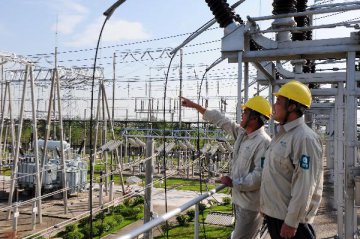
The Communist Party of China (CPC) on Tuesday issued the full text of proposals for China's development from 2016to 2020, setting a target of "maintaining medium-high growth."
Although no numerical targets were offered, President Xi Jinping expounded in a later explanation that annual growth of 6.5 percent would be required for China to "build a moderately prosperous society" by 2020.
"For China to double 2010 GDP and the per capita income of both urban and rural residents by 2020, annual growth for the 2016-2020 period must be at least 6.5 percent," according to Xi's statement. He said the target was proposed after considering both economic potential and risks.
As China's economy steps into the "new normal," it takes time and space to digest industrial over-capacity, restructure the economy and shift to an innovation-driven mode, he added. China's economy expanded 6.9 percent year on year in the third quarter of 2015, the lowest reading since the second quarter of 2009, but in line with the government target of around 7 percent.
Liu Yuanchun, deputy director of the National Academy of Development and Strategy at Renmin University, said if effective measures were taken, China could maintain growth around 7 percent for the next five years.
Even if the aging population, economic restructuring and resource restraints hold up growth, the pace won't fall below 6 percent, Liu reckoned. Chi Fulin, director of the China (Hainan) Institute for Reform and Development, said the 6.5 percent bottom line allows leeway for ensuring sustainable growth.
The change of growth mindset, according to Chi, will have a long-lasting impact on China's future. According to Tuesday's proposals, "innovation, coordination, the environment, opening up and sharing" will fulfill its economic goals for the coming years.
The focus is to seek growth through economic transformation, optimizing industrial structure, improving the environment and enhancing quality and efficiency, Xi noted.
FASTER URBANIZATION
One of the tasks in the five-year plan is to increase the urbanization ratio based on the number of registered residents. That ratio is expected to reach around 45 percent by 2020.
Although the number of people who actually live in cities is already near to 55 percent of the whole population, a significant number of them, mostly migrant workers, are denied "hukou" (official residence status) and barred from equal education, employment rights and social security services.
To make the migrant workers "real" urbanites is significant for the labor supply, consumption demand, stabilizing the property market and expanding urban infrastructure investment, Xi said. It will also benefit social fairness and justice, key to the 2020 goal of a well-off society.
POVERTY RELIEF
China plans to lift all of its poor out of poverty by 2020. Eliminating poverty in rural areas is the most difficult challenge in building a "moderately prosperous society," according to Xi.
As of the end of 2014, China had 70.2 million people in rural areas below the poverty line -- annual income below 2,300 yuan (376 U.S. dollars, 2010 rate). The government plans improved rural infrastructure, including roads, access to water, power and Internet.
Better education, healthcare and public services are also promised, along with a social services system for "left-behind" children, women and the elderly. While increasing fiscal expenditure on poverty relief, private investment and community groups will be encouraged to join the battle against poverty.
"If the government takes concrete and effective action, China can lift 10 million people out of poverty every year from 2016 to 2020," said the president, achieving the 2020 poverty relief target.
CHILD POLICY CHANGE
The change to the birth control policy means the end of the one-child policy, allowing all couples to have two children. The new policy will balance the population and supporting development, the president said.
At the end of August this year, only 1.69 million couples, 15.4 percent of those eligible couples, had applied to have a second child, according to the explanation note.
Over 15 percent of the population is 60 years old or above. The working-age population has started to decrease and "the trend is continuing," the note said.
The new policy should reduce the pressure of an aging population, increase the labor supply and promote balanced population development, according to Xi.
























Latest comments